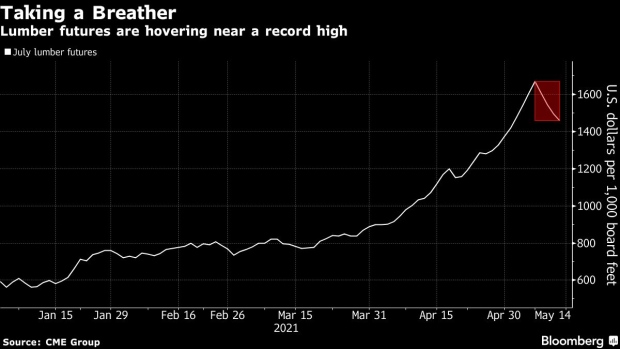May 13, 2021
Lumber prices hover below record in wild trading as demand roars
, Bloomberg News

U.S. lumber futures hovered below a record high in wild trading, but nonstop demand from builders combined with tight supplies means the rally may be far from over.
July futures rose by the exchange’s maximum daily trade limit on Thursday but then dropped to limit-down levels, all within two hours. The most-active July contract traded 2.7 per cent lower at US$1,453 per 1,000 board feet at 11:50 a.m. on the Chicago Mercantile Exchange after reaching an all-time high of US$1,733.50 on Monday.
Lumber prices have soared in the past year amid an unexpected surge in house building and renovations that left sawmills scrambling to catch up to demand. Though lumber’s climb began last year, the frenzy comes amid a broader rally in everything from steel to corn as vaccination campaigns allow countries to reopen and fiscal stimulus pumps up the U.S. economy. Lumber’s gains threaten to price out home buyers, with data from the National Association of Home Builders showing that the cost of boards for the average U.S. house rose by near nearly US$36,000 over the last year.
Many order books at mills are now extended until June, with deliveries to builders and retailers for new orders not expected to arrive until July. Exacerbating the situation for all producers is a trucking shortage, which limits the amount of lumber that can be transported even as mills ramp up production. Lumber prices will increase into the U.S. summer months before turning lower, according to Forest Economic Advisors LLC.
“We expect a peak will occur in July-August at which point more lumber will start flowing to market as supply chain disruptions, a lack of rail cars and trucks to transport lumber to market, ease,” said Paul Jannke, principal at Forest, a wood product analysis company near Boston.
Jannke expects the most-active futures contract could rise to US$1,800 per 1,000 board feet, if there are not extensive wildfires this year. A bad fire season, however, could see prices top US$2,000.

In April, Resolute Forest Products Inc. said its order book exceeds its inventories. Interfor Corp. has said North American lumber inventories are at “critical levels.” Canadian lumber producers plan to ramp up U.S. production by expanding existing mills, but this will take years.
Limited “on ground” lumber supplies, combined with the unusual circumstances created by the pandemic, make it difficult to forecast price movements, said Joy Robles, who trades lumber on the cash market for Sherwood Lumber on Long Island, New York.





